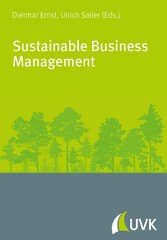
Sustainable Business Management
von: Dietmar Ernst, Ulrich Sailer
UVK Verlagsgesellschaft mbH, 2015
ISBN: 9783864968198
Sprache: Deutsch
338 Seiten, Download: 8966 KB
Format: EPUB, auch als Online-Lesen
1 Sustainable Development – an Introduction
by Ulrich Sailer
Learning Objectives
The readers
- are familiar with the term sustainable development and its origins,
- know how the term sustainable development evolved from the Brundtland Report to the Three-Pillar-Model,
- recognize the inherent tensions between traditional models of business management and sustainable business.
List of Key Terms
Greenwashing Brundtland Report Three-Pillar-Model Corporate Social Responsibility (CSR) Corporate Citizenship Compliance
Should we even bother with the term sustainability these days? It is used in an inflationary fashion and for many different purposes. It is mocked as a buzzword and often abused rather than used. We frequently do not know what an author means concretely when he uses the term. One author may use sustainability simply as a synonym for something that has a long-term or lasting effect. Another one may imply the full weight of the → Brundtland Report, the → Three-Pillar-Model and the recommendations of the study commissions from various parliaments. And a third author talks about sustainability because today products and services are absolutely expected to have that feature. Who would want to buy anything else?
Especially this frequent and undifferentiated use, the misuse of the term and also the abusive → greenwashing result in the fact a number of observers think of sustainability as a worn out and trendy term which should consciously be avoided. Those who continue to work on business sustainability issues in academia are frequently forced to justify, in a slightly apologetic manner, why they still use the term. And this is exactly what the authors of “Sustainable Business Management” discussed. Now that business management has been “turned sustainable,” many a cynic might consider such a volume to be unavoidable. As we can already choose sustainable vacation travel, biological and sustainable wine and sustainable electrical power, it is inevitable that somebody also wants to sell the idea of sustainable business management. But isn’t good business management already sustainable? Hasn’t the goal of our management science always been to develop healthy companies which can grow sustainably? In that case, there is no reason for the discipline of business management to listen to the lectures of the supporters of sustainability who stress its narrow-mindedness. Not far away is an ideological debate about social romantics and do-gooders, who want to seize the opportunity offered by the spirit of the times to take revenge on business management. Given these challenges, it is unsurprising that a number of people try to distance themselves from the term of sustainability. There is a real danger that the message is misunderstood or that the author is associated with the wrong crowd.
It is clear that the term sustainability cannot be used lightly. But we feel it is our responsibility to seize the opportunities for advancing the field of business management which arise from a critical discussion of sustainability. Sustainable business management is neither a complete concept nor an ideology. And it is absolutely not the case that traditional business management is abandoned completely or discredited as hopelessly one-sided and incomplete. Instead we are looking at an evolutionary development, which confirms many insights from classical business management, makes numerous additions and also refutes several ideas.
How can we define “sustainable” so that it is useful and enriching for business management? If we google the term, we get more than 100 million hits in less than half a second. But where does the term originate? Sustain has its roots in the Latin word sustinere, which can be translated as maintain, carry, preserve or keep. Sustainability thus implies stable structures which at the same time provide sufficient reserves for the future.1 The origin of sustainability is regularly traced back to forestry, where the limits of short-term overexploitation were already decried centuries ago. Due to lengthy regeneration times and the slow growth of forests, the necessity for a caring treatment of the natural resource wood is obvious if the supply is to be assured over the long term. Only that amount of wood can be harvested which is replaced in type and quantity. Today sustainable development still reflects the self-image in forestry.
Discussions about sustainability frequently make reference to the so-called → Brundtland Report from the year 1987. Gro Harlem Brundtland, born in 1939, is a Norwegian politician and member of the Social Democratic Party. She was minister of the environment in the seventies and later until 1996 repeatedly prime minister of Norway. She narrowly escaped the terrorist attack on the Norwegian island Utoya, since she only left the island shortly before. Beginning in 1983, Brundtland headed the “World Commission on Environment and Development” which was assembled by the United Nations. The final report of the commission is entitled “Our Common Future” and is frequently called → Brundtland Report. The report is credited with mapping out the principles of sustainable development and coining the term sustainability. It is stated: “Sustainable development meets the needs of the present without compromising the ability of future generations to meet their own needs.”2 Sustainable development thus expresses awareness for the responsibility for future generations and the environment. Restraint is exercised and options are foregone in order to enable future generations to have their own options.
A few years later, in June 1992, the first United Nations Conference on Environment and Development took place in Rio de Janeiro. Approximately 10,000 participants from 178 countries compiled lines of action for a sustainable global development. Sustainable development was designated as a guiding political principle. This was based on the insight that global environmental protection is possible only if social and economic aspects are also taken into consideration. This developed into the → Three-Pillar-Model of Sustainability, which consists of an economic, an ecological and a social pillar. If one of the aspects is ignored, sustainability collapses. Unsurprisingly, this initiated a discussion about the most important pillar and the appropriate handling of conflicts among the aims. Should environmental pollution be tolerated if it creates employment? Or should democratic processes be avoided, since a majority is possibly opposed to a project which protects the environment?
Figure 1-1: Three-Pillar-Model of Sustainability
Example: Beiersdorf AG
“We manage our business sustainably and are committed to our ecological and social responsibility. Our actions are determined not only by our company’s economic success, but also by our active approach to environmental protection and occupational safety, and by our commitment to society. Our actions are based on a culture of trust, fairness and equality of opportunity.”3
The following Table lists for each of the three pillars the societal dimension alongside the practical implementation at the company level.
Table 1-1: Societal and business dimensions of sustainability
Especially the field of business management frequently stresses the importance of reaching clear decisions on the basis of unambiguous relationships among variables. Introductory business courses already teach the importance of studying linkages between variables, clarifying conflicts among competing aims and defining a clear hierarchy of targets. Admittedly, this is grounded in a rather mechanical model of a company. On the basis of clearly defined target systems, exactly defined binding constraints and complete information, it is possible to develop solutions that are theoretically clean, but usually have little in common with business reality. In our daily lives, however, we are quite capable of dealing with imprecision, missing information and contradictions. And numerous companies manage to strike an appropriate balance between economic, ecological and social considerations in the face of possible contradictions. Instead of weighing the targets against each other, a commensurate and lasting balance of targets is important. The transfer of the → three-pillar-model to the business world makes it clear that defining the success of a company by maximizing a single key performance indicator it is no longer possible.
This leads us to an important insight for sustainable business management. Ecological and social targets are not merely additional guidelines for the company, further guard rails, which reduce the scope of management even further. Thus it is not just business as usual with less freedom. We should not discuss sustainable business management in such a traditional mode of thinking. Instead we are abandoning strictly linear thinking and company management as managing a machine. Not individual targets are maximized, but instead a balance of targets is sought. Contradictions, incomplete or even incorrect information are a part of daily operations. Not “either – or,” but instead “as well as” shapes our understanding of reality.4
Example:...










